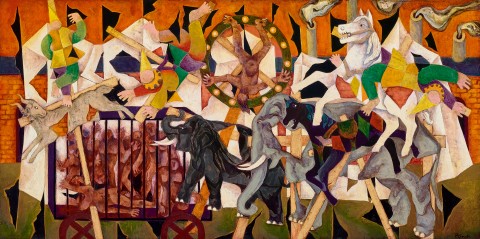FAÇADE, 1981
LEONARD FRENCH
from the DARK CIRCUS series
enamel on hessian on board
60.5 x 122.0 cm
signed lower right: French
inscribed with title and date on handwritten label attached verso: “Façade” 1981 / Study for a Mural
Joseph Brown Gallery, Melbourne
Private collection, Melbourne, acquired in 1990
Joseph Brown Gallery, Melbourne, 1 – 14 September, 1982, cat. 116 (illus. in exhibition catalogue)
Façade, 1980-1981, enamel on hessian covered hardboard, 122.0 x 244.0 cm, private collection, illus. in Grishin, S., Leonard French, Craftsman House, Sydney, 1996, pl. 35, pp. 130 – 131, 168
One of the most idiosyncratic talents in Australian art, Leonard French forged his own path from relative obscurity to astonishing popularity. Training as a signwriter while pursuing part-time art classes, the artist was initially taken under the wing of Melbourne Technical College lecturer, Victor Greenhalgh, who identified his prodigious talent and later gave French a teaching position. French became further captivated by the Melbourne art scene when he frequented the Swanston Family Hotel in Swanston Street after classes, an establishment also patronised by numerous emerging Antipodean artists including Arthur Boyd, John Perceval, Clifton Pugh, Charles Blackman and John Olsen. The combination of his teaching and signwriting studies, together with regular debates among his artist peers at the Swanston Family Hotel (such congregations were later known as ‘Len French’s University’1), enabled French’s burgeoning artistic vision to solidify and, from the late 1950s, French’s ascent was meteoric, winning in quick succession the Crouch, Perth, Peace Congress, Sulman and Blake prizes – the latter of which he won a second time in 1980.
With the Australian art scene in the late 1960s and 1970s dominated by movements such as colour field abstraction, French’s presence thus became increasingly marginalised as he plunged himself more fully into the figurative idioms that would define his later work. Describing himself as a ‘dog among the fairies’2, in 1981 he embarked upon his some of his most overtly figurative work with the ‘Dark Circus’ series which, permeated by a mood of impending gloom, elaborated upon the dark allegories of captivity and death first explored in his ‘Death of a Revolution’ series in the early 1970s. Indeed, elaborating upon French’s use of the circus iconography, art historian Sasha Grishin suggests: ‘The metaphor of the circus of life has attracted many artists, from the carnivals of Bruegel and Ensor to the clowns and harlequins of Rouault, Léger and Picasso, and in Australian art the ballroom dancers of John Brack, the carnival scenes of John Perceval and the performance arena of Andrew Sibley's grand circus. French's arena is a circus of cut-out facades; among them are rocking horses, and toy elephants which he has appropriated from his daughter's picture books. Behind the facade lies the darkness…’3
The spectacular climax to the series which implicitly presents as a journey with an initiation and progression, Façade 1981 exudes a sense of colourful dynamism and excitement, beneath which lies something quite ominous and frightening. A boy crucified on a wheel forms the centre of the composition while below, naked bodies are crammed into a cage like animals and, in the distance, the menacing furnace which – reminiscent of the abandoned Hoffman Brickworks where the artist painted as a child – bears unmistakable associations with the Nazi gas chambers. As Grishin observes, ‘…all seem to rush along, as if on Bruegel’s cart of suffering humanity, or as part of Uccello’s Rout of San Romano turned into a scene of apocalyptic horror with chimney stacks belching ominous emissions into a blood red sky. The strange, disjointed elephants and rocking horses may be a reference to a merry-go-round from the artist’s childhood. He remembers such a merry-go-round where there were broken heads and legs falling off the horses. There may also be unconscious references to his sign painting days… these suspended signs would be ripped by the wind, and through the ripped cloth you could glimpse passages of blue sky, wooden fences or walls of corrugated iron. The painting [Façade, 1981] explores this incongruity of layers of reality, where behind the façade one could catch a glimpse of another plane of being…’4
1. Heathcote, C., A Quiet Revolution: the rise of Australian art 1946-1968, Text Publishing, Melbourne, 1995, p. 63
2. ‘Leonard French, a man apart’, Weekend Australian, 18 – 19 April 1981
3. Grishin, S., Leonard French, Craftsman House, Sydney, 1995, p. 53
4. Ibid., pp. 54 – 55
VERONICA ANGELATOS
